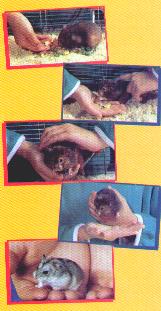
Handling your Hamster
{ Home | Care Guide
}
From the Book
Hamst ers handled frequently from a young age usually remain docile and seldom bite. These animals of a docile nature can be
picked up gently by cupping in one or both hands and held against one's body. Beware that even docile hamsters may bite if
surprised or abruptly awakened from sleep.
ers handled frequently from a young age usually remain docile and seldom bite. These animals of a docile nature can be
picked up gently by cupping in one or both hands and held against one's body. Beware that even docile hamsters may bite if
surprised or abruptly awakened from sleep.
Other hamsters, however, may not have received a lot of attention and handling throughout their lives, and thus may be more
apprehensive and aggressive. Any animal whose personality is not fully known must be approached cautiously. The use of a
small towel or gloves can assist the handler in capturing and restraining such a pet. Another method of capture involves
coaxing
the animal into a container (such as a can or tube), which can then be removed from the cage. Once removed from the cage,
biting hamsters can be restrained by grasping a large amount of skin at the scruff of the neck. As much skin as possible must
be
grasped using this method because their skin is very loose. If lightly scruffed, the hamster can easily turn around within its skin
and bite the handler.

Experienced
Hamsters are very popular pets today. They are small, odorless, gentle, clean, and easy to care for. They will thrive for up to
6 years in a birdcage or glass aquarium. Hamsters are entertaining to humans, they explore any new thing in their cage (and
old
thing), dig nest after nest after nest (you can never have enough nests) and if you have a wire cage, they will climb up the walls
and even sometimes o
n the ceiling! If you supply your hamster with a wheel, it may run 4-8 miles on it! Most pets require
attention and daily care, but hamsters can be left alone for an entire weekend if necessary, because they hoard food and do not
drink very much. Since they are not really social pets, they probably wouldn't miss you as much as another pet would.
Hamsters are very inexpensive to keep, and are more durable when it comes to falls, bumps, etc more than
other rodents. This makes them good pets for kids.
Playtime!
 ) Then take your hamster to a designated play area. This can be anything from sitting on your lap on the floor, to having the free run of a large plastic wading pool (this makes a great run/play area if you have the space) or the bathub.
) Then take your hamster to a designated play area. This can be anything from sitting on your lap on the floor, to having the free run of a large plastic wading pool (this makes a great run/play area if you have the space) or the bathub.  We usually play with two hamsters at a time (watch those Syrians!!!) for about 30 minutes.
Then they go into a rolling ball for about 45 minutes or whenever they stop rolling around.
We usually play with two hamsters at a time (watch those Syrians!!!) for about 30 minutes.
Then they go into a rolling ball for about 45 minutes or whenever they stop rolling around.